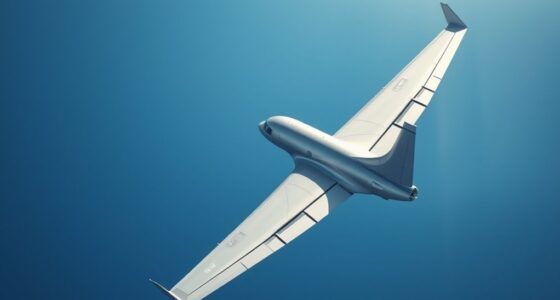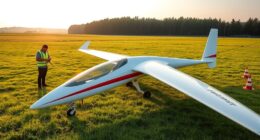To perform side-slip techniques for short-field landings, bank the aircraft into the wind using ailerons, then apply opposite rudder to keep the nose aligned with the runway. Maintain gradual control inputs to increase drag, allowing a steeper descent without excess speed. Monitor your airspeed and descent rate carefully, and smoothly shift to leveling off before touchdown. Proper execution ensures precise landings within limited space—if you want to master the details, keep exploring this approach.
Key Takeaways
- Use ailerons to bank the aircraft into the wind and rudder to keep the nose aligned with the runway during the slip.
- Maintain a gentle, coordinated control input to avoid excessive bank angles or rudder deflection.
- Keep the descent rate steady while adjusting pitch and power to control airspeed and glide path.
- Transition smoothly to align the aircraft with the runway before touchdown, using visual cues.
- Ensure proper communication, plan abort procedures, and avoid slips in turbulent conditions for safety.
Understanding the Purpose of Side-Slip in Short-Field Landings
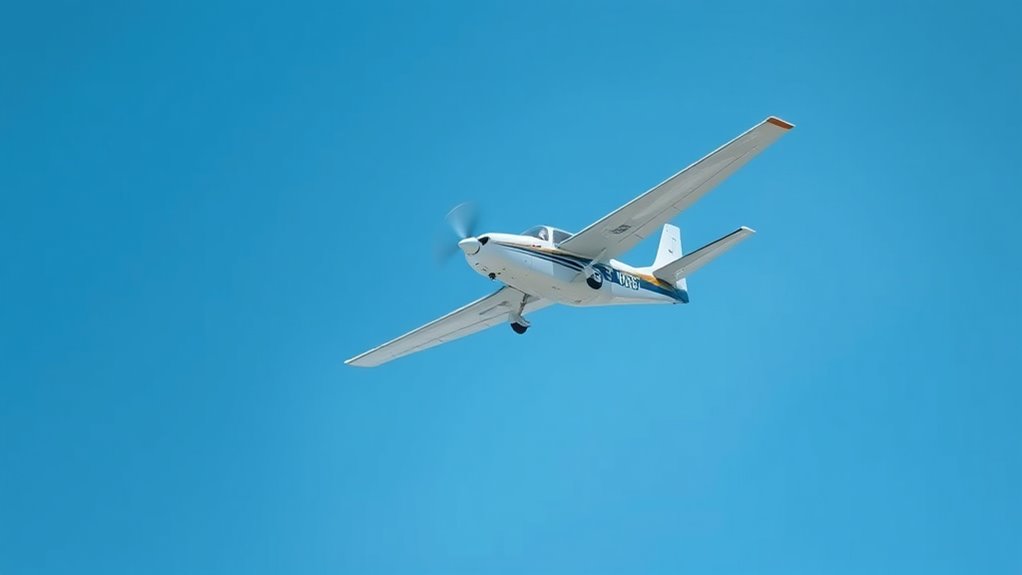
Understanding the purpose of a side-slip in short-field landings is essential for safely reducing your landing distance. This maneuver leverages aerodynamic principles to allow you to descend more steeply without increasing speed, helping you land within a limited space. During pilot training, you learn how side-slipping adjusts your aircraft’s alignment with the runway, counteracting wind drift and reducing the need for excessive runway length. By intentionally banking the aircraft into the wind and controlling your descent rate, you can touch down at a lower speed and in a more precise position. This technique is especially useful when landing on short runways or in challenging conditions, giving you better control and minimizing the distance needed to stop safely.
When and Why to Use a Side-Slip Approach
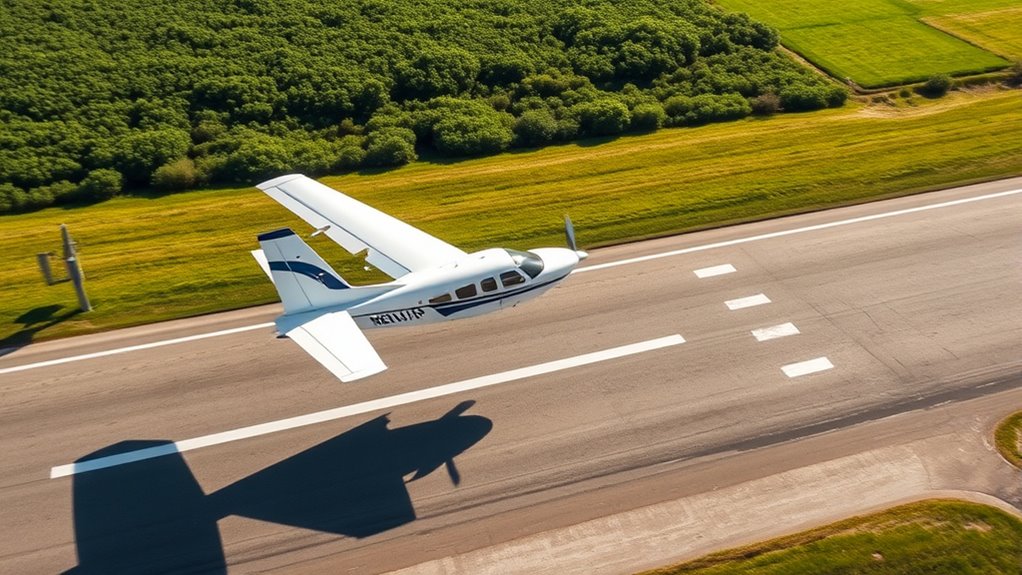
You should consider using a side-slip approach when approaching short fields to guarantee a safe, controlled landing. It’s also effective in managing crosswind conditions, helping you keep the aircraft aligned with the runway. Additionally, side-slips can improve landing precision in tricky wind situations.
Approaching Short Fields Safely
When approaching a short field, pilots often use a side-slip to maintain better control and achieve a precise touchdown point. This technique is especially helpful when you need to keep the aircraft’s nose high and slow down quickly. To do so safely, consider these points:
- Ensure your aircraft configuration is set correctly—flaps extended, landing gear down.
- Use your pilot training to execute a controlled slip without losing situational awareness.
- Maintain the appropriate bank angle and descent rate for precision.
- Be mindful of your airspeed and coordinate the slip smoothly to avoid excessive altitude loss or control issues.
- Incorporating proper payment processing techniques can enhance operational efficiency during training and pre-flight preparations.
A proper side-slip approach allows you to land within a short runway’s limits, provided you’re trained for it and can manage aircraft configuration confidently.
Managing Crosswind Conditions
Managing crosswind conditions often requires pilots to adjust their approach techniques to maintain control and guarantee a safe landing. Weather considerations, such as wind direction and strength, influence when a side-slip approach is appropriate. When crosswinds exceed the aircraft’s limitations or make a crab approach unstable, using a side slip helps counteract drift and keep the aircraft aligned with the runway centerline. This technique is especially useful during the final approach, where precise control is critical. By banking into the wind and lowering the wing into the wind, you can effectively offset the crosswind component. Always evaluate your aircraft’s limitations before choosing a side-slip, and ensure you’re familiar with the technique to avoid overstressing the aircraft or compromising safety during challenging wind conditions. Additionally, understanding the role of contrast ratio in projected images can help pilots better visualize approach paths in training simulations, enhancing overall safety and accuracy.
Enhancing Landing Precision
Have you ever struggled to align your aircraft precisely with the runway during the final approach? A side-slip can enhance landing precision when visual cues and ground reference points are essential. Use this technique when:
- The runway isn’t aligned with your approach path, making a straight descent difficult.
- Wind conditions cause drift, requiring precise correction.
- Visual cues are clear, helping you judge your position relative to the ground.
- You need to minimize ground roll on a short runway, ensuring a controlled touchdown.
A side-slip allows you to maintain proper alignment without losing altitude, using ground reference points to guide your correction. It’s especially effective when visual cues are available, giving you a reliable way to improve landing accuracy in challenging conditions.
Proper Techniques for Executing a Side-Slip

To execute a side-slip correctly, you need to establish a controlled angle of the aircraft relative to the runway while maintaining directional control. Begin by banking the aircraft into the desired slip angle using the ailerons, usually banked toward the windward side. Simultaneously, apply opposite rudder to counteract aircraft yaw and keep the nose aligned with the runway. This yawing motion increases aerodynamic drag on one side, helping slow the aircraft and alter its descent path. Maintain gentle, coordinated inputs to prevent over-controlling. Focus on keeping the aircraft’s longitudinal axis aligned with the runway while the sideslip angle creates the necessary lateral displacement. Employing proper control coordination ensures a stable, effective side-slip, reducing landing distance without compromising safety.
Managing Airspeed and Descent Rate During a Side-Slip
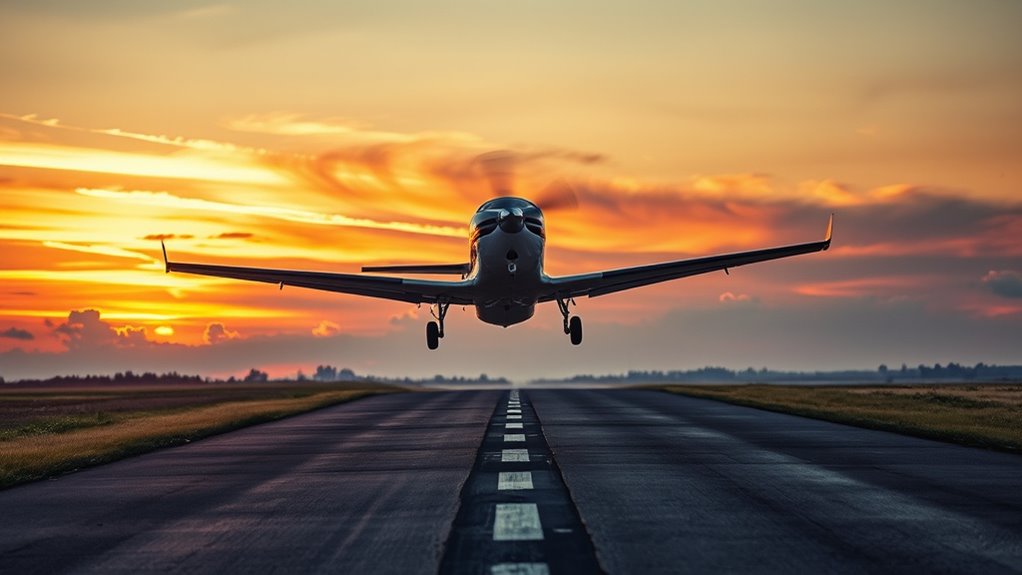
Controlling airspeed and descent rate during a side-slip requires careful adjustment of your aircraft’s controls to maintain the desired descent path without losing stability. Monitor your airspeed closely, as aerodynamic effects can cause it to fluctuate; use power or pitch adjustments to keep it steady. Maintain a consistent descent rate by adjusting the pitch attitude, ensuring you don’t increase pilot workload unnecessarily. Use coordinated control inputs—ailerons and rudder—to balance the aircraft, minimizing aerodynamic drag that can affect your descent. Keep an eye on your descent angle, making small corrections to avoid excessive speed or a steep descent, which increases workload and reduces control. Being aware of aircraft stability helps pilots adjust control inputs effectively to maintain safe and controlled side-slips.
Transitioning From Side-Slip to Touchdown

As you prepare to bring the aircraft to a normal landing from a side-slip, focus on gradually aligning the aircraft’s longitudinal axis with the runway centerline. Use your rudder to correct your crosswind component, guaranteeing the aircraft stays aligned with the runway. Simultaneously, monitor visual cues such as the runway edges and centerline to gauge your alignment. As you reduce the angle of the slip, smoothly apply opposite aileron to level the wings and bring the aircraft straight down the centerline. Keep your eyes on the visual cues to confirm your corrections. This gradual shift helps to ensure a stable, accurate touchdown, minimizing side forces and maintaining control. Be patient, and make small, deliberate inputs to achieve a smooth, aligned landing.
Safety Tips and Common Pitfalls to Avoid
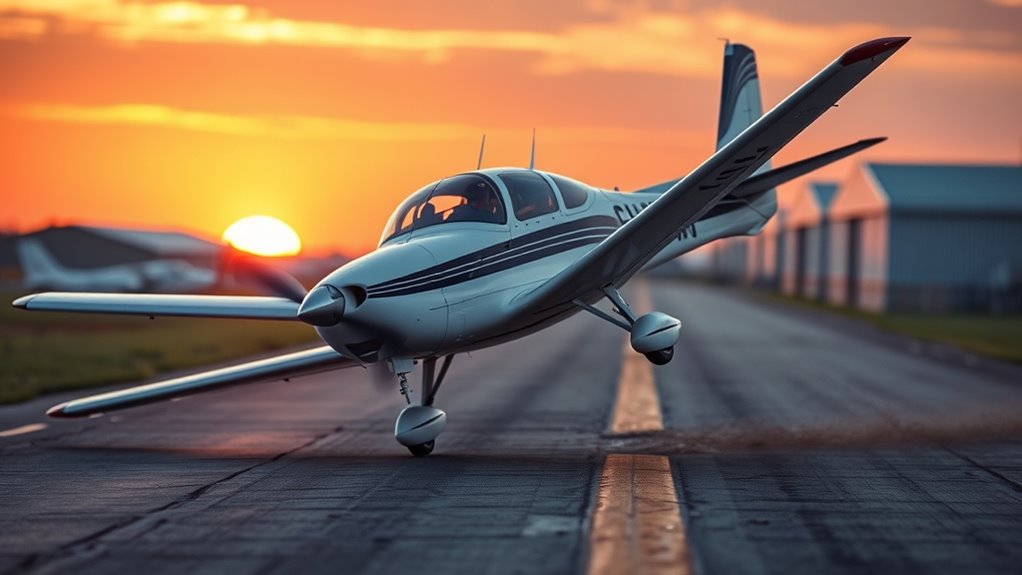
Maintaining safety during side-slip maneuvers requires vigilance and attention to detail. Proper pre-flight planning is essential to identify suitable terrain and weather conditions, reducing risks. Be aware of common pitfalls, such as over-rotation or excessive bank angles, which can compromise control. Always review emergency procedures to handle unexpected situations, like sudden wind shifts or mechanical issues. To stay safe:
Vigilance, proper planning, and awareness of pitfalls are key to safe side-slip maneuvers.
- Confirm your aircraft’s weight and balance are within limits before attempting a side-slip.
- Practice in calm conditions and avoid slips in turbulent air.
- Maintain clear communication with yourself and, if applicable, your crew.
- Have a well-rehearsed plan for aborting the slip or executing a go-around if needed.
- Understanding the importance of appliance maintenance plans can help ensure that all aircraft systems are functioning properly before flight.
Staying alert and prepared minimizes risks and ensures safe, successful short-field landings.
Frequently Asked Questions
Can Side-Slip Techniques Be Used in Crosswind Conditions?
In crosswind conditions, you can use side-slip techniques for effective crosswind management and ground track control. By intentionally banking the aircraft into the wind and lowering the upwind wing, you counteract the drift caused by the crosswind, helping you stay aligned with the runway centerline. This technique allows you to maintain better control during landing, especially on short runways, ensuring a safer, more precise touchdown despite challenging wind conditions.
How Does Wind Direction Affect Side-Slip Execution?
Imagine you’re steering through a dance with the wind as your partner. Wind direction acts like an unseen hand guiding your slip angle, demanding precise wind correction. If the wind blows from the side, you’ll need to modify your slip to counteract drift effectively. Properly aligning your side-slip ensures a controlled descent, helping you land safely when the wind teases your aircraft off course. Mastering this dance keeps you steady and confident.
Are There Aircraft Limitations for Side-Slip Landings?
You should always check your aircraft’s limitations before attempting a side-slip landing. Aircraft configuration plays a vital role, as some planes aren’t designed for side-slips and could sustain damage. Proper pilot training is essential to understand these limitations and execute the maneuver safely. If your aircraft’s manual specifies restrictions, follow those guidelines strictly to avoid structural stress or loss of control during the landing.
What Are Signs of Improper Side-Slip Technique?
When performing a side-slip, watch for common errors like excessive bank angle, improper rudder use, or uneven descent. Signs of an improper technique include increased drag, difficulty maintaining heading, or uncommanded yaw or roll. To correct these issues, adjust your bank angle gradually, coordinate rudder input smoothly, and monitor your descent rate. Practicing precise control and awareness helps guarantee a safe, effective side-slip during short-field landings.
How Should Visibility Issues Influence Side-Slip Use?
Imagine the cockpit becomes a lighthouse guiding you through fog; visibility issues demand precise instrument approach and heightened cockpit coordination. You should rely more on instruments, trusting your gauges over external visuals, and communicate clearly with your crew. Use side-slip cautiously, ensuring your control inputs are smooth and deliberate. This approach helps you maintain safe alignment with the runway, even when visual cues are limited, ensuring a safe landing despite challenging visibility.
Conclusion
Mastering side-slip techniques can markedly improve your short-field landings, especially on limited runways. Did you know that proper use of side-slip can reduce landing distance by up to 20%? By understanding when and how to execute this maneuver safely, you enhance your control and safety during challenging approaches. Practice these techniques diligently, and you’ll gain confidence in managing tight quarters, ensuring safer, more precise landings every time.
With a heart that soars as high as the skies, Aria, affectionately known as “Skylark,” is the driving force behind Soaring Skyways. Her journey into the gliding world began as a young dreamer gazing up at the soaring birds, yearning to experience the weightlessness and freedom they embodied. With years of experience both in the cockpit and behind the scenes, Aria’s commitment to the gliding community is unwavering.






